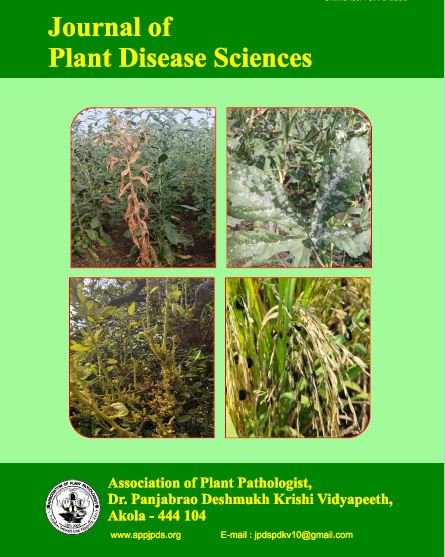EFFICACY OF FUNGICIDES AGAINST COLLETOTRICHUM GLOEOSPORIOIDES CAUSING STEM END ROT AND FRUIT DROP IN MANDARIN
DOI:
https://doi.org/10.48165/jpds.2024.19.02.12Keywords:
Colletotrichum gloeosporioides, Fungicides, Efficacy, Inhibition, MandarinAbstract
Mandarin (Citrus reticulata Blanco) is one of India's most important citrus crops, contributing to about 40% of the total citrus cultivation. However, its productivity is severely impacted by stem end rot and preharvest fruit drop, primarily caused by Colletotrichum gloeosporioides. This fungal pathogen spreads rapidly under humid and warm conditions, leading to significant yield losses. The present study was conducted to evaluate the efficacy of various fungicides against C. gloeosporioides using the poisoned food technique in a laboratory setting. Fungal isolates were obtained from diseased mandarin fruits collected from university orchards. Pathogenicity was confirmed using Koch’s postulates. A total of sixteen chemical fungicides were tested for their ability to inhibit mycelial growth. The most effective fungicides at both half dose and recommended dose were:References
Anonymous. (2004). Field problems of fruit crops (1st ed.). Centre for Communication and International Linkages, Punjab Agricultural University.
Agostini, J. P., Timmer, L. W., & Michell, D. J. (1992). Morphological and pathological characteristics of strains of Colletotrichum gloeosporioides from citrus. Phytopathology, 82, 1377-1382.
Ann, Y. C., & Mercer, Z. J. A. (2017). Efficacy of tebuconazole and trifloxystrobin against Colletotrichum gloeosporioides infestation in black pepper (Piper nigrum L.). American Journal of Research Communication, 5(1), 98-128.
Chung, W. H., Ishii, H., Nishimura, K., Fukaya, M., Yano, K., & Kajitani, Y. (2006). Fungicide sensitivity and phylogenetic relationship of anthracnose fungi isolated from various fruit crops in Japan. Plant Disease, 90, 506-512.
Forcelini, B. B., Seijo, T. E., Amiri, A., & Peres, N. A. (2016). Resistance in strawberry isolates of Colletotrichum acutatum from Florida to quinone-outside inhibitor fungicides. Plant Disease, 100, 2050–2056.
Gautam, A. (2014). Colletotrichum gloeosporioides: Biology, pathogenicity, and management in India. Journal of Plant Physiology & Pathology, 2(2). https://doi.org/10.4172/2329-955X.1000125
Goes, A. D., & Kimati, H. (1997). Morphological characterization of isolates of Colletotrichum acutatum and Colletotrichum gloeosporioides associated with post-bloom fruit drop disease. Summa Phytopathologica (Brazil).
Ingle, S. H., Giri, G. K., Gulhane, A. R., & Konde, S. A. (2008). Management of fruit drop of Nagpur mandarin using bioagents, botanicals, and fungicides. Journal of Plant Disease Sciences, 3(2), 219-221.
Ishii, H., Watanabe, H., Yamaoka, Y., & Schnabel, G. (2022). Sensitivity to fungicides in isolates of Colletotrichum gloeosporioides, Colletotrichum acutatum, and species complexes and efficacy against anthracnose diseases. Pesticide Biochemistry and Physiology, 182, 1-10.
Mahiout, D., Bendahmane, B. S., Benkada, Y., Mekouar, M., Berrahal, H., & Rickauer, N. (2018). First report of Colletotrichum gloeosporioides on citrus in Algeria. Phytopathologia Mediterranea, 57, 355–359.
Mohod, Y. N., Giri, G. K., Ingle, Y. V., & Gade, R. M. (2019). Variability on morphological characters of Colletotrichum gloeosporioides isolates from Nagpur mandarin. Journal of Plant Disease Sciences, 14(1), 71-75.
Nene, Y. L., & Thapliyal, P. N. (1993). Fungicides in plant disease control (3rd ed.). Oxford & IBH Publishing Co.
Ranjitha, N., Devappa, V., & Sangeetha, C. G. (2019). Evaluation of fungicides against Colletotrichum gloeosporioides (Penz.) Penz. & Sacc., the incitant of mango anthracnose. Journal of Pharmacognosy and Phytochemistry, 8(3), 812-814.
Vincent, J. M. (1947). Distortion of fungal hyphae in the presence of certain inhibitors. Nature, 159, 180.
Nilkhan, S. G., Ingle, Y. V., Paithankar, D. H., & Patil, Y. B. (2024). Efficacy of fungicides against Colletotrichum gloeosporioides causing stem-end rot of fruit drop in Mandarin. Journal of Plant Disease Sciences, 19(2), 155-159. https://doi.org/10.48165/jpds.2024.19.2.158

